As I had hoped for, the scattered thunderstorms scattered indeed away from the main land and caused more issues over the sea with generating squalls with considerable wind around the rainclouds. But with rain at sea there is always a fair chance of a dry day ashore and indeed Dubrovnik showed its sunny self. A bit on the chilly side when out of the sun, but for sightseeing that is more of a plus than a minus. We docked around 09.30 and this time the ship had to be parked between two other ships. At the end of the pier there was a local Ferry called the Dubrovnik and far inside the newest ship of Viking Cruises the Viking Sea. It is a very long pier and thus we had ample room to get the 300 meters of the Koningsdam in between. Official arrival time was 10 am. and just before the clock struck 10, the local authorities had cleared the ship and the guests could go ashore via the two gangways which had been put out. Shuttle buses and tour buses were waiting and a benign invasion of Dubrovnik had started.
For the crew the chance to go ashore came in the afternoon if they are not on safety duty, but about a 100 of them had to attend lifeboat training first. As it was perfect weather we lowered all the portside boats into the water. With the sun and hardly any wind it was perfect for our objectives of bringing more and more routine into the operation. Thus the whole portside when down in the water, sailed around and then came neatly back on board just before noon time.
I have been blogging extensively about the beautiful inside of the ship but today a few things about the outside. When you look at the outside of a cruise ship you see a lot of peculiar things which are there for good reason, but what is the good reason?
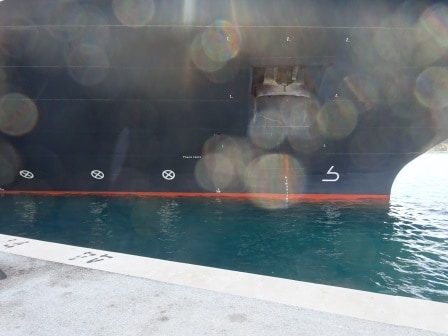
From right to left. Bulb sign. Draft mark. Frame number at the water line. Above the tank indications and to the left the 3 bow thrusters signs.
Starting at the bow, there are several markings. First the indication of the bulbous bow. Although everybody can see it, it is compulsory to have an indication to warn smaller sailing craft about bumping into it. Then there are the three propellers signs indicating the location of the bow thruster. Again compulsory and there to warn anybody of the possible propeller wash. Finally above it is a mark with some letters. This is to indicate the boundaries of the various tanks inside the hull. In this case WB = Water Ballast, then the tank nbr. and then a name indication Forepc = forepeak tank. At the water line there is a number which indicates the frame number of the ship. The ships frames are about 80 centimeters apart and the Koningsdam has about 370 of them.
Looking up there are the windows of the main deck cabins. Due to the curving bow the windows are more recessed towards the bow and not so much while coming to the flat hull of the ship. A second reason for the recess is for bad weather. With the windows recessed the waves will hit the hull and not the glass. Above these windows is a little rail with nozzles. This is for cleaning the window glass as with the recessed widows it is hard for the sailors to get the scrubbers in.
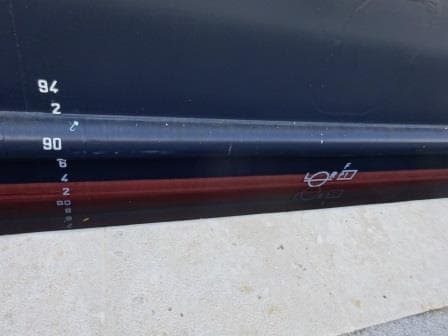
The Plimsoll Mark to the right. The draft marks to the left. Above, the ships rubbing stroke, a sort of car bumper for a ship.
Half way down the ship there is the Plimsoll mark. Invented in the mid-19th. Century by a gentleman called Mr. Hall if I remember correctly. Then a British politician Mr. Plimsoll took on the challenge to have the system turned into law, which was not easy as it meant ships could only load until the line of the Plimsoll mark which became the water line. This was good for the safety of the ship but not so good for the bottom line of the company finances. But Plimsoll managed to get the law passed in Parliament and his name got attached to the draft mark. Basically it allows a ship to have a certain draft in certain areas. Cargo ships have sometimes 5 or 6 options. For cruise ships it is a lot easier and the Koningsdam has two. The maximum draft in seawater P1 and then a deeper draft in fresh water F. As fresh water provides less buoyancy than salt water, the ship will automatically sink in a bit more with the same ships weight. Hence two lines. The L and R indicates Lloyds Register under which control the ship was built and they approved the ships stability as well. To the left are the draught marks with the Koningsdam having a draft of 8 meters.
More to follow.
This evening we sail at 6 pm. and then head for Kerkira on Corfu for the day and hop over to Sarande for an evening call. We are looking at partly cloudy skies with temperatures around 66oF or 19oC and it is not supposed to rain.
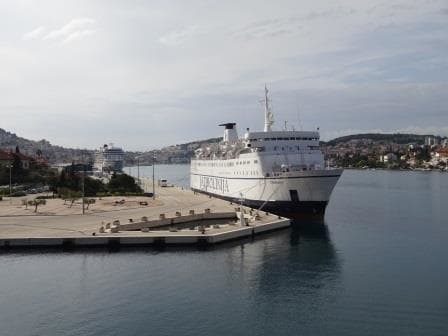
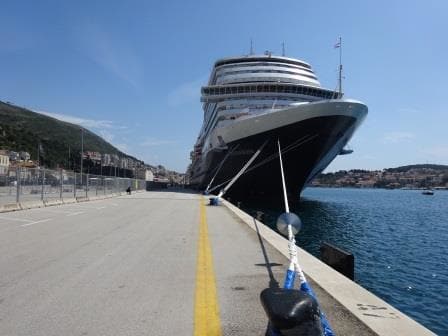
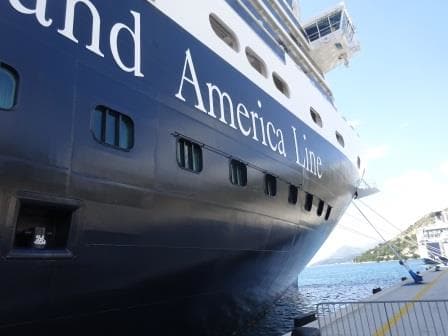

April 10, 2016 at 2:41 pm
Capt Albert, your blogs are simply fascinating. I especially loved today’s, with the explanations of various features and markings on the hull. Thank you!
April 10, 2016 at 4:34 pm
Great daily update about the maiden Voyage of the Koningsdam.
Can hardly wait till August 28th when we will join her, seems still so far away.
April 11, 2016 at 6:47 pm
Thank you, too Captain! Here’s another one who appreciates your explanations of details I often look at and wonder (although you have dealt with some of the signage before). It’s time I start remembering …
What luxury – three bow thrusters. I suppose they need to be there looking at the bow the lady has on the picture you made. But, checking on the “almost correct Google”, the Eurodam and the Nieuw Amsterdam have them too.
Looking forward to the “More to follow”.
April 12, 2016 at 5:09 am
Follow up on our trip through the Straits of Messina. I don’t want to bother the driver, sorry Captain De Vries, but I noticed a strong current flowing through the Straits and wondered if this was normal and the source of the current in the “tideless” Mediterranean. It’s a great trip and your blog adds to the enjoyment as I sit in a bar in Katakolon looking out at our “home” for the next few weeks. Keep up the great work.
John.
April 12, 2016 at 9:56 am
Thank you for reading my blog.
I was doing the same today. Sitting on the boulevard having Greek Lunch overlooking the harbor. Life can be very good. Yes there can be a very strong current running in Messina Straits. Up to 5 knots is possible. Although there is not much tidal height difference in the Med Sea, there is still flow and as with other places in the world (Such as Seymour Narrows in Canada) the water tries to keep going and when the hole gets smaller, the current strength increases. Comes through southbound this time we had just over 3 knots.
Best regards
Capt. Albert